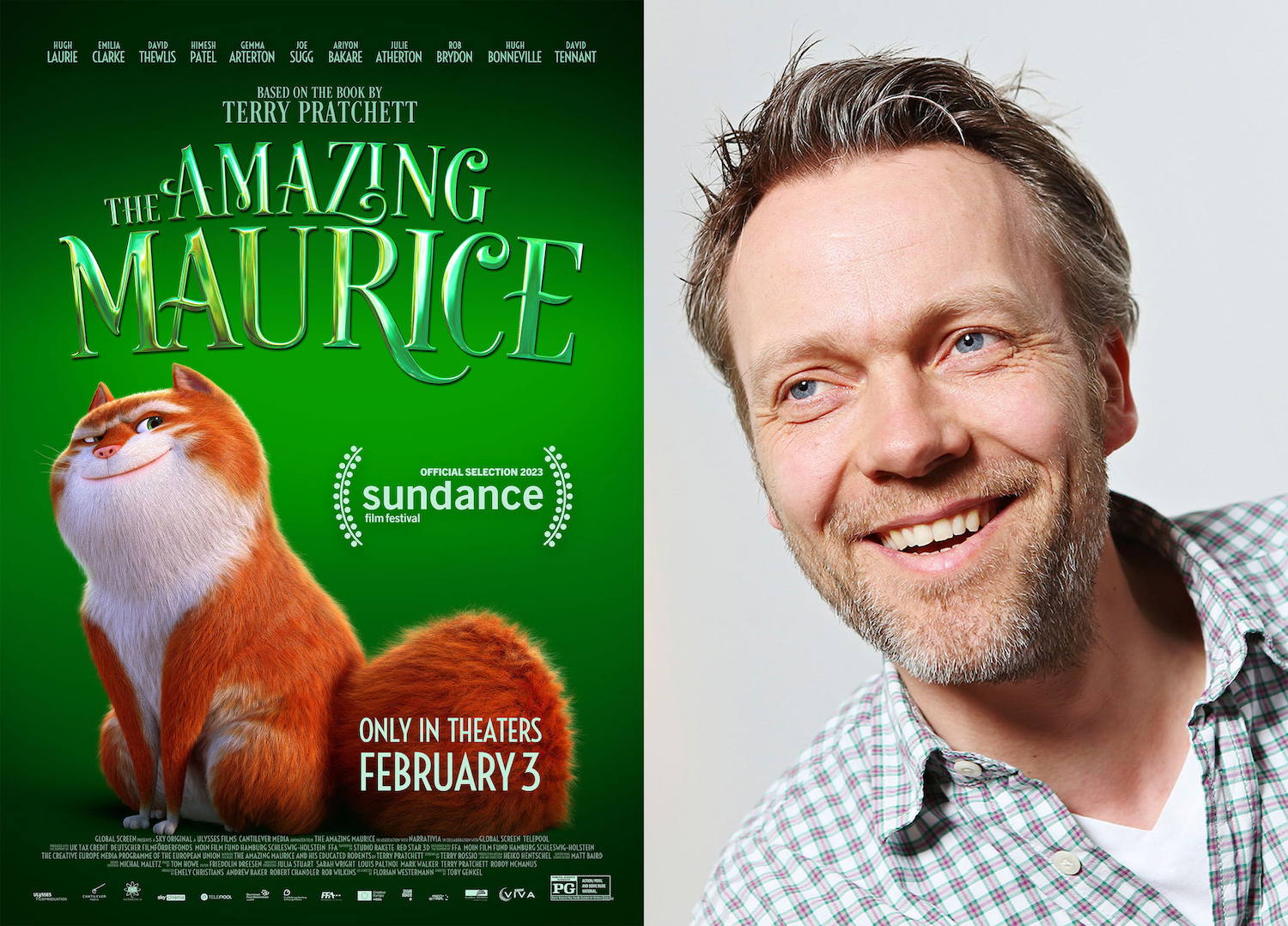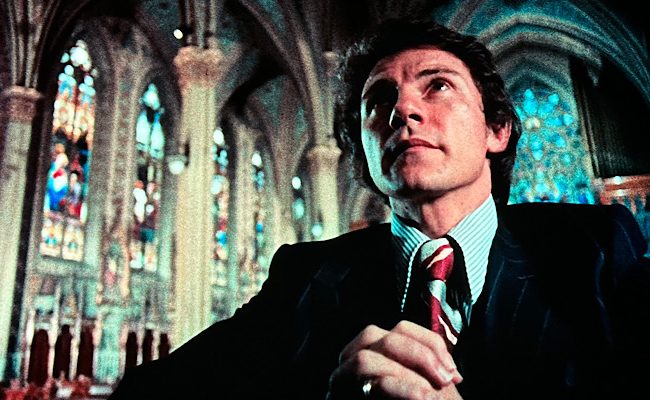A Conversation with Toby Genkel (THE AMAZING MAURICE)

The new animated film The Amazing Maurice had its premiere at the 2023 Sundance Film Festival (where I reviewed it), and came out in theaters on February 3. An adaptation of Terry Pratchett’s The Amazing Maurice and His Educated Rodents (part of the Discworld series), the movie follows the titular cat and his merry band of talking rats as they do their best to save a small town from the predations of a nasty villain. As the festival began, I met virtually with director Toby Genkel to chat about the film. Here is a transcription of that conversation, edited for length and clarity. Genkel speaks excellent English, though his native language is German. Where I have had to adjust the language to make it fit American idioms, I have done so.
Hammer to Nail: How did this project initially come to be?
Toby Genkel: The project was actually started by producer Emely Christians. For a long time, she tried to get the rights to the Terry Pratchett book. And about eight years ago—we would have to double-check with Emely—she finally got the rights.
HtN: So how long have you been involved with the film?
TG: About three years.
HtN: And by the time you became involved, there was already a script in place?
TG: There was a draft of the script. Yes.
HtN: Let’s talk briefly about your own background. I read how you started out as a storyboard artist.
TG: I actually started as something else, before. I started as a trainee, probably like everybody else. And I actually started painting backgrounds and I started in an animation studio without having any idea how animation is made. So I had the chance to learn it from scratch, pretty much, in an animation studio in Hamburg, where I drew layouts. It might be worth mentioning that those were the beginning of the ‘90s. We were quite far away from any sort of 3D animation. So this was all 2D, with big cameras with the cels and the copy machines and it was very, very, very old school. This is where I come from.
HtN: Some amazing films have been made using that old-school technology. Cel animation, of course, is what all the classic Disney films were made on. So there’s no shame in that.
TG: No. I’m grateful that I had the chance to see the old times. And those techniques were amazing. I have to say, when you think about it, what we had to do to make things work, there were so many limitations in there that we had to think in a totally different way.

A still from THE AMAZING MAURICE
HtN: Absolutely. My own background is not so much as a film critic but as a filmmaker. And when I was learning film, I was cutting on film. So I have a great appreciation for learning the traditions. How were you, then, asked to be on this project? Did you have a relationship with the producers already? Why did they turn to you?
TG: We had a previous relationship. We had made two movies together: Ooops! Noah Is Gone… and A Storks Journey. And we realized we get along very well. So we said, if we get the chance to get our hands on a project like this, it would be great to do it together.
HtN: Were you a Terry Pratchett fan before being asked to do this film? Were you familiar with the source material?
TG: Honestly? No, I wasn’t. I knew Terry Pratchett, of course. I knew the Discworld, but I would never call myself a fan because I’ve worked with fans, and they have a level of expertise that I don’t. But when I read the books and the novels that we talked about, I became a fan, straight away. It’s so obvious why people love him all over the world.
HtN: Yeah, absolutely. I’ve read some Terry Pratchett, but I haven’t read this particular book. So how much of the tone of your movie comes from the novel and how much did you and the screenwriter bring to the screen?
TG: That, of course, is a difficult question. Where to draw the line? Thank God there is no line. If there would be, probably nobody would step over it. But what we tried to do, as a team, was to capture that Pratchett tone, which is very, very unique. He has his very own way of combining this wacky humor and this social commentary at the same time. That said, I think Terry Rossio, the screenwriter, did an excellent job. When you bring a book to the screen, you can never do it 100%. You have to make decisions, painful ones, particularly when you have such a great book in your hands; every line you take out, it’s going to be painful. But I think Terry Rossio made some very, very good decisions. He had some great ideas to bring the book to the screen.
HtN: I understand the dilemma, but you cannot treat a book that you’re adapting as a sacred text, otherwise your film might end up being lifeless.
TG: Exactly. Absolutely.
HtN: And since I haven’t read the book, I can’t tell what you did differently and I did enjoy the film very much. So, my understanding of the animation process on a feature film is not nearly as sophisticated as my understanding of live action. On an animated film like this, what is the collaboration like between you, the official director, and someone like your character designer, Carter Goodrich.

A Still from THE AMAZING MAURICE
TG: When it comes to the characters, what I always do is write a character briefing. And when your characters are animals, what I do is, if these animals were human, what kind of humans would they be? And just like us, all our characters have different dimensions to them. It’s not just one trait. So I say, “You’re a little bit of this and a little bit of that and a little bit of this.” And then I add photos and then I write very little. Because all I want is to inspire the design. I don’t want to build a cage around him.
If you work with somebody like Carter Goodrich, you want to have him charge ahead and just do it. So in this case, for Maurice, I had Robert De Niro as Al Capone representing the power (not because of the fleshiness or arrogance). Then I had Jack Black because of the expressiveness and also the physical antics he has to pull very suddenly. And the last one, pretty ironic, was Hugh Laurie as Dr. House, and I still lack the words to say how cool it is that he actually ended up doing the voice there. It was at least two years before we even thought about having him for real, but he was already part of the character.
HtN: I’m glad you brought up Hugh Laurie because I want to pivot to the casting and how that worked. So again, in an animated film, my understanding is that you wouldn’t necessarily animate what’s happening on the screen until you have the voices recorded because you have to match the animation to that. So at what point in this three-year process of your involvement did you get the cast set and how did that work?
TG: Well, I can’t take credit for the casting. I can just be grateful for these great talents that we were allowed to work with. The casting was mostly the work of producers Robert Chandler and Andrew Baker, and of course the casting agents Debbie McWilliams and Jemima McWilliams. While that was going on, we had already started making the movie, beginning with animatics, and making little films for the storyboards and adding dialogue to it. And in the beginning, we started with so-called scratch voices; some we did ourselves or we had actors and we did it very quickly and roughly to get the story started and to find out if the story is working. We did not do that, and we could not afford to do that, with the top-shelf talent. So basically the movie was there and then we recorded the voices knowing that the dialogue works and what, exactly, we needed. Because, as an independent production, we were lucky to have these great voices, but our timeframe was limited.
HtN: And then how did you direct these great actors once they were in the studio?
TG: First of all, we did not show them the animatics with the scratch voices. We wanted them to be free of any influence. So the only influence they got, basically, was my direction. And because these are fantastic actors, you want to let them do it their way. They have their specific rhythms, all of them. So what you do is you tell them the surroundings, you describe the scene, you give them directions pretty much, and then they go ahead, and since you have the film in your head, you can direct them. Like, “I need the line more upbeat or sadder, I need it faster or shorter.” Most of the time what we did was, “More and more, more expressive, go crazier, mess it up even more.”
And in terms of how many takes we might do, that would depend. Often, you have a first take and then you do one or two for safety. There were times we might do one for 30 or more, perhaps. No specific rule to it, but I guess that’s the same as in live action. Sometimes you just have it and you go like, “Okay, let’s do one for safety.” And then sometimes it needs a little bit of time to find it. But I can tell you what we did most is, we started with one, it was great. Then we’d say like, “If this one’s so good, let’s do another one.” And then it was better. And this one went better and we actually, we stopped and we said like, “Alright, it’s not getting any better.” And so it went.
HtN: Toby, thank you so much. It was a pleasure talking to you.
TG: Thank you very much.
– Christopher Llewellyn Reed (@ChrisReedFilm)
Toby Genkel; The Amazing Maurice movie












Pingback: From Our Members’ Desks (Feb. 13, 2023) – Online Film Critics Society
Joe
Great interview! And yes, Terry Rossio is an amazing screenwriter and did a perfect job with this movie!
Christopher Reed
Glad you liked! Thanks for reading!